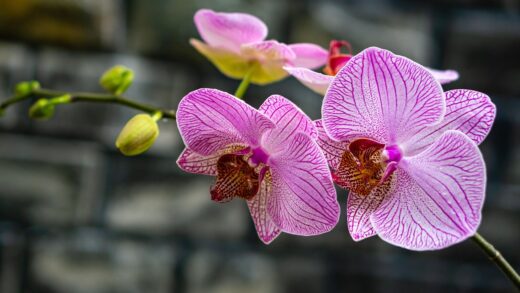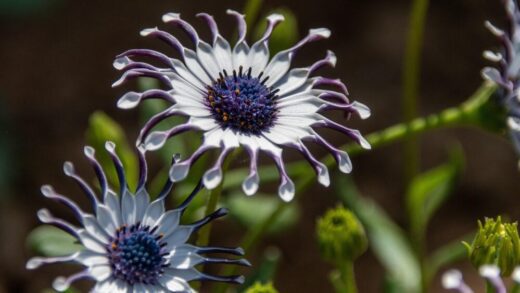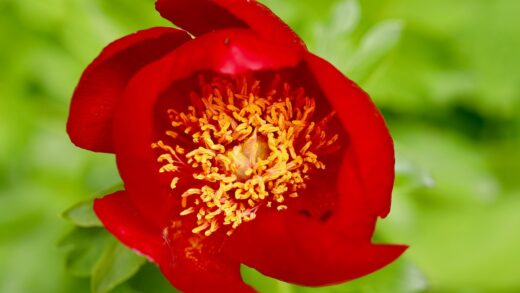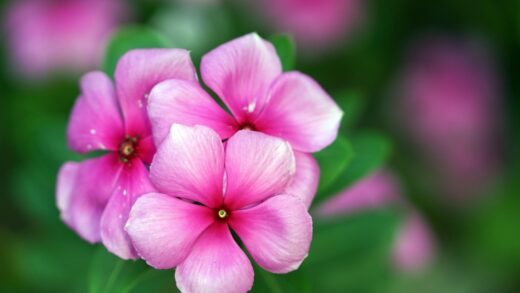Despite its reputation as a hardy and resilient shrub, the dog rose is not entirely impervious to the challenges posed by various diseases and pests. However, its robust nature means that it is often less afflicted than its more highly bred, modern rose cousins. A healthy, well-sited, and properly cared-for dog rose will have a strong natural ability to fend off many potential problems. The key to successful management lies in prevention, early detection, and employing integrated pest management (IPM) strategies. This approach prioritizes creating a healthy garden ecosystem and using the least toxic control methods first, resorting to chemical treatments only when absolutely necessary. Understanding the most common threats is the first step toward keeping the plant healthy and thriving.
The most common diseases that affect the dog rose are fungal in nature, with powdery mildew and black spot being the most frequent culprits. These diseases are highly dependent on environmental conditions, flourishing in periods of high humidity, warm temperatures, and poor air circulation. Therefore, preventative measures that address these conditions are the most effective line of defense. This includes choosing a planting site with full sun and good airflow, and practicing strategic pruning to open up the structure of the shrub, allowing light and air to penetrate the center of the plant.
When it comes to pests, the dog rose can attract a range of sap-sucking insects, such as aphids, which are particularly fond of the soft, new growth in spring. While a large infestation can weaken the plant and distort growth, small populations are often kept in check by natural predators in a balanced garden environment. Encouraging beneficial insects like ladybugs, lacewings, and hoverflies by planting a diverse range of flowering plants is a cornerstone of organic pest control. This creates a self-regulating system where pests rarely reach damaging levels.
Regular monitoring of the plant is crucial for early detection of any issues. A walk through the garden to inspect the leaves and stems of the dog rose every week or so can help you spot the first signs of trouble, whether it be the white dusting of mildew or a cluster of aphids on a new bud. Catching problems early, when they are small and localized, makes them much easier to manage. A simple action, like removing a few affected leaves or washing off a small aphid colony, can often prevent a major outbreak from developing later in the season.
Common fungal diseases
Powdery mildew is one of the most easily recognizable fungal diseases, appearing as a distinctive white or grayish, powder-like coating on the surface of leaves, stems, and flower buds. The fungus thrives in warm, humid conditions but, unlike many other fungi, does not require free water on the leaf surface to germinate. This is why it can be a problem even during dry spells when humidity is high. An infection can cause leaves to curl, yellow, and drop prematurely, and in severe cases, it can reduce the plant’s overall vigor and flowering capacity.
More articles on this topic
The best defense against powdery mildew is prevention through cultural practices. Ensuring the dog rose is planted in a location with ample sunlight and good air circulation is paramount. Pruning to thin out dense growth improves airflow through the canopy, which helps to lower the localized humidity around the leaves. If an infection does take hold, it is important to prune out and destroy the most heavily affected parts of the plant to reduce the number of fungal spores. For persistent problems, spraying with horticultural oil, neem oil, or a potassium bicarbonate solution can be effective.
Black spot is another prevalent fungal disease, identified by the characteristic black or dark purple spots that appear on the upper surface of the leaves. These spots are often fringed with a yellow halo, and as the disease progresses, the entire leaf will turn yellow and fall from the plant. This premature defoliation can weaken the shrub, making it more susceptible to other stresses like winter cold. Black spot spores require several hours of continuous moisture on the leaves to germinate, so the disease is most severe in wet weather.
Managing black spot revolves around minimizing leaf wetness. Watering the plant at its base with a soaker hose rather than overhead sprinklers is a critical preventative measure. It is also important to practice good garden sanitation by collecting and disposing of any fallen leaves, as the fungus can overwinter on this debris and reinfect the plant in the spring. If chemical control is deemed necessary, fungicides containing copper or myclobutanil can be used, but they should be applied preventatively before the disease becomes established.
Other diseases like rust and canker
Rose rust is another fungal disease that can affect dog roses, though it is often less common than black spot or powdery mildew. It is easily identified by the small, bright orange or rust-colored pustules that appear on the undersides of the leaves. If you rub an infected leaf, an orange, powdery substance will come off on your fingers. In late summer and autumn, these pustules may turn black as the fungus produces its overwintering spores. A severe infection can cause leaf distortion and significant defoliation, weakening the plant.
More articles on this topic
Control measures for rose rust are similar to those for other fungal diseases. Good air circulation, proper pruning, and avoiding overhead watering are key preventative steps. It is particularly important to clean up and destroy all fallen leaves in the autumn to reduce the source of infection for the following year. In the spring, inspect new growth carefully and remove any infected leaves as soon as they are noticed. Fungicides effective against black spot are often also effective against rust if applied early in the season.
Canker is a more serious issue that affects the woody stems and canes of the rose. It is caused by various fungi that enter the plant through wounds, such as those created by improper pruning, insect damage, or winter injury. Canker appears as a sunken, discolored (often brown, purple, or black) area on a cane. As the canker grows, it girdles the stem, cutting off the flow of water and nutrients to the parts of the plant above it. This results in the wilting and eventual death of the affected cane.
The primary management strategy for canker is prevention through careful pruning. Always use sharp, clean secateurs to make clean cuts, and time major pruning for the dormant season when the plant is less susceptible to infection. If canker is found, the only effective treatment is to prune out the infected cane completely. The cut must be made well below the cankered area, into healthy, green wood. It is essential to disinfect your pruning tools with rubbing alcohol or a bleach solution between each cut to avoid spreading the fungal spores to healthy parts of the plant.
Identifying and managing common pests
Aphids are small, pear-shaped, sap-sucking insects that are among the most common pests of the dog rose. They tend to congregate in dense colonies on the most tender parts of the plant, such as new shoots, flower buds, and the undersides of young leaves. Their feeding can cause new growth to become distorted, curled, or stunted. As they feed, they also excrete a sticky substance called honeydew, which can lead to the growth of sooty mold, a black fungus that coats the leaves and can interfere with photosynthesis.
Managing aphids is often a matter of patience and encouraging natural controls. A healthy population of predators, including ladybugs, lacewings, and hoverflies, can keep aphid numbers in check. For small, localized infestations, a strong jet of water from a garden hose is often sufficient to dislodge them from the plant. If the problem persists, spraying with insecticidal soap or neem oil is an effective, low-toxicity option. These treatments work on contact and have minimal impact on beneficial insects once dry.
Spider mites are another type of sap-sucking pest, but they are technically arachnids, not insects. They are incredibly tiny and difficult to see with the naked eye, but their presence is often revealed by a fine, silky webbing on the plant and a stippled or mottled appearance on the leaves. Spider mites thrive in hot, dry conditions. As with aphids, a strong spray of water can help to dislodge them and raise the humidity, which they dislike. Horticultural oils and insecticidal soaps are also effective controls.
Caterpillars of various moth species can also feed on the foliage of the dog rose. They may chew holes in the leaves or roll leaves together with silk for shelter. Hand-picking is a very effective control method for small numbers of caterpillars. Simply inspect the plant and remove any that you find. For larger infestations, a spray containing Bacillus thuringiensis (Bt) can be used. This is a naturally occurring bacterium that is toxic only to the larvae of moths and butterflies and is safe for other insects, birds, and mammals.
Dealing with rose gall wasps
A particularly fascinating, though sometimes alarming, pest specific to roses is the rose gall wasp (Diplolepis rosae). This tiny insect causes the formation of one of the most distinctive and bizarre-looking galls in the plant world, known as the Robin’s Pincushion or bedeguar gall. The gall is a large, mossy-looking growth, often tinged with red, which develops on the stems or leaves of the rose. It is formed when the female wasp lays her eggs within the plant tissue, and the plant’s hormonal response to the larvae creates this unique structure.
Inside the gall is a complex of chambers, each containing a single wasp larva. The gall provides both food and protection for the developing larvae throughout the summer and winter. While the appearance of a large, hairy growth on a dog rose can be quite startling to a gardener, it is important to understand that these galls cause very little actual harm to a healthy, mature plant. They do not significantly impact the plant’s vigor, flowering, or hip production.
Because the damage is primarily cosmetic and does not threaten the life of the plant, control measures are often unnecessary. In fact, many people find the galls to be an interesting and attractive natural curiosity. However, if you wish to control their numbers or prevent their spread, the most effective and simplest method is mechanical removal. The galls are most conspicuous in late summer and autumn.
To control the population, simply prune off the stems that bear the galls. This should be done before the adult wasps emerge in the late spring of the following year. Once removed from the plant, the galls should be destroyed, for example by burning or sealing them in a bag and placing them in the trash, to prevent the larvae from completing their life cycle. There is no effective chemical treatment for gall wasps, so physical removal is the only viable control strategy.


















